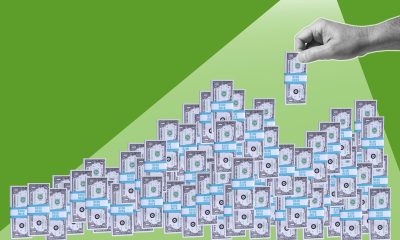Personal Finance
Over 25% of Americans contributed 3% or less to retirement plans

Americans’ retirement savings patterns made some shifts following a year marked by stubborn inflation and economic uncertainty, a study shows.
More than a quarter of Americans (26%) saved 3% or less in their 401(k) plan, according to a study by Bank of America. The cohort with the greatest amount of people contributing 3% or less was the Baby Boomers (43%), the study said. And the average contribution rate across all age groups was 6.4%, down from 6.6% the previous year.
The recommended contribution rate is 15%, according to a Fidelity Investment’s retirement roadmap. But while that may not be attainable for many, especially under turbulent economic conditions, experts say contributing any amount can help.
“Saving for retirement may seem like a steep mountain to climb, but the climb doesn’t have to be as steep as it looks,” Fidelity Vice President Ann Dowd said in a post. “Small steps now can turn into big strides later.”
And saving in a retirement account like a traditional 401(k) and individual retirement account (IRA) has distinct benefits. Contributions to these types of accounts are tax deductible. That means they could lower your tax bill.
If high-interest debt is getting in the way of your retirement savings, you could consider paying it down with a personal loan at a lower rate. Visit Credible to get your personalized rate in minutes, without affecting your credit score.
RETIREES LOST 10% OF THEIR SAVINGS IN 2022, SURVEY SAYS
Hardship distributions decreased in Q4 2022
Although total savings rates are down, less Americans were making hardship withdrawals in the fourth quarter. The portion of 401(k) plan participants who made hardship withdrawals in the fourth quarter dropped to 0.4% from 0.5% in the third quarter, BofA found. A hardship withdrawal allows participants to take money from 401k(k)s and other employer-sponsored retirement plans to cover emergency needs. When Americans did make withdrawals, the average amount that Americans took in hardship withdrawals for the last quarter was $4,700, down 8% from the third quarter.
While hardship withdrawals may sound like convenient ways to cover immediate expenses, these could have consequences. A hardship withdrawal permanently removes money from retirement savings that won’t benefit from any compound interest or investment gains. Plus, participants generally will owe income tax on the withdrawal and a 10% tax penalty if they took it before the age of 59.5. In addition, participants who make hardship distributions can’t make any deferrals six months afterward.
“Even though hardship withdrawals are done in undesirable but inevitable situations, an individual should evaluate the disadvantages thoroughly so that the long-lasting effects are fully understood,” the Corporate Finance Institute (CFI) said in a post.
If you’re struggling in today’s economy, consider paying down high-interest debt with a personal loan at a lower interest rate. Visit Credible to speak with a personal loan expert and get your questions answered.
NEARLY HALF OF WORKERS DON’T HAVE A 401(K): HERE’S HOW YOU CAN START SAVING
SECURE 2.0 Act aims to reshape retirement planning industry
To make it easier for Americans to save for retirement and maximize their savings, Congress recently passed the Secure 2.0 Act. This legislation was designed to bring sweeping changes to the retirement plan space. Here are some of its highlights at a glance.
“The passage of SECURE 2.0 is an important step in increasing Americans’ ability to improve their financial security,” Maurice Perkins, Transamerica chief corporate affairs officer, said in a statement. “We have been long-time, strong advocates for policies that help American workers increase their retirement savings and financial health.”
If you’re looking to reduce high-interest debt to make more room for retirement plan contributions, you could consider taking out a personal loan with a lower interest rate. Visit Credible to compare options from different lenders without affecting your credit score.
SECURE 2.0 ACT: AMERICANS WILL BE ABLE TO MAKE TAX-FREE TRANSFERS OF 529 PLAN FUNDS TO ROTH IRAS
Have a finance-related question, but don’t know who to ask? Email The Credible Money Expert at moneyexpert@credible.com and your question might be answered by Credible in our Money Expert column.
Read the full article here

-

 Side Hustles6 days ago
Side Hustles6 days agoHow Charlotte’s Rally Pickleball Got Its Start
-

 Make Money6 days ago
Make Money6 days ago5 Surprising Ways Trump’s Trade Agenda Could Affect What You Pay at Checkout
-

 Investing6 days ago
Investing6 days agoQuantum stock soars on new file system client By Investing.com
-

 Side Hustles4 days ago
Side Hustles4 days agoKickstart Your Year With These Entrepreneurial Health Checkups
-

 Side Hustles3 days ago
Side Hustles3 days agoExpand Your Global Reach with Access to More Than 150 Languages for Life
-

 Side Hustles2 days ago
Side Hustles2 days agoKFC Announces Saucy, a Chicken Tenders-Focused Spinoff
-

 Investing2 days ago
Investing2 days agoPalantir, Anduril join forces with tech groups to bid for Pentagon contracts, FT reports By Reuters
-

 Side Hustles3 days ago
Side Hustles3 days agoThis AI is the Key to Unlocking Explosive Sales Growth in 2025


















